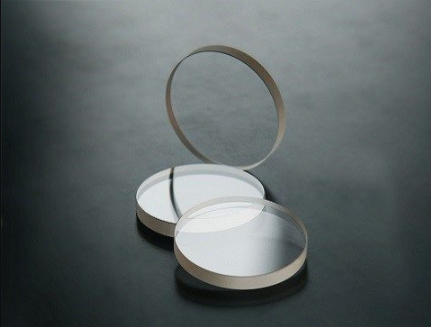Optical filter : a complete guide
Light is an electromagnetic radiation, this radiation is an integration of different wavelength from the UV (shorter wavelength) to the IR (longer wavelength). Therefore each light beam can be decomposed in different beam of specific wavelength. Below you’ll find details about optical filters and how they can be used to control the flow of light:
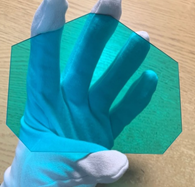
BG39 colored glass optical filter.
What is an optical filter ?
An optical filter is an optical element that reduce the incident beam signal to a specific part of it, either reducing its intensity or reducing it to specific wavelength range or polarisation.
! An optical filter is often defined with an angle of incidence (AOI), a use at a different angle may shift the value of the cut-on/ cut-off wavelength by several nm.
Different types of optical filters ?
Below you’ll find presentation and some details abouts the most common optical filters available on the market.
Bandpass filters
Bandpass filters are used to let only the part of the signal within a predefined narrow wavelength band passing through the component. The signal within the band will usually have a high transmission around 90% while the signal outside of the band will be attenuated by a factor of 10^4 (OD4) to a factor of 10^10 (OD10).
Important factors for the good choosing of a bandpass filter is the center wavelength value tolerance which define where the bandpass will be situated and the FWHM which will define the width of the bandpass. FWHM value depends on the wavelength requested and can be as low as 1nm, but more common value is several tenth of nanometres.
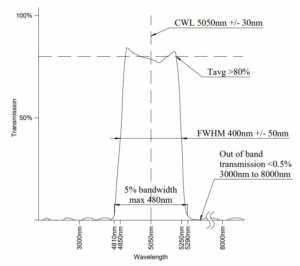
Transmission curve of a 5,1µm bandpass filter, with a FWHM of 400nm.
Acronyms definitions:
- FWHM : FULL WIDTH at HALF MAXIMUM, value of the transmission range where transmission measured is half the maximum transmission value.
- CWL : CENTER WAVELENGTH, center value of the (often Gaussian) transmission peak.
- Tavg : Average transmission.
Longpass & shortpass filters
Longpass and shortpass filters are respectively blocking transmission before a specified wavelength or after it. For example if you have a 850nm longpass filter every signal with wavelength lower than 850nm including visible and UV light will not pass through while longer wavelength like IR light will pass through.
Key points in a longpass or shortpass filters are :
- Transmission value before or after the cut-on / cut-off wavelength
- OD of the non transmitted wavelength (expressed in OD : Optical Density)
- Cut-on / cut-off slope, usually lower than 5%. Defined as the slope the between the wavelength at half the peak transmission to the wavelength at 1/10^4 of the peak transmission.
- Cut-on / cut-off tolerance : position of wavelength at 50% of peak transmission. Usually several nm according to the wavelength value.
Naming: of longpass and shortpass filters : The name usually include letter (L & S) for example for Long or Short and a value. The value is the nominal cut-on or cut-off wavelength at 50% peak transmission.
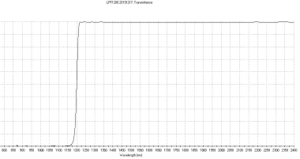
Example of a longpass filter transmission curve with nominal value of 1200nm
Notch filters
Notch filters can be defined as the opposite of bandpass filters, for vulgarisation we could call them no-pass-band filter. They are blocking only a narrow band of the wavelength while non affecting the transmission of the other wavelengths.
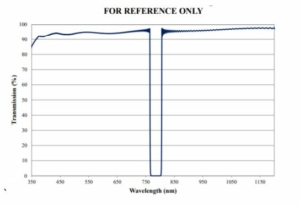
Example of a 775nm notch filter transmission curve
Hot & Cold mirrors
Hot mirrors are shortpass mirrors that transmit the visible and reflect the IR wavelengths.
Cold mirrors are longpass mirrors that reflect the visible but transmit the IR wavelengths.
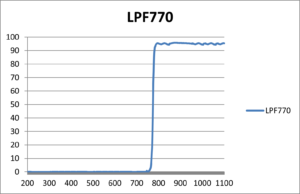
Example of a transmission curve of a cold mirror coating.
Colored glass filters
Colored glass filters raw material comes directly from the glass manufacturer. Extra coating may be added to enhance their properties and they can be cut in shape, round, square or freeform according to the needs.
There are many suppliers of these materials and therefore many references and transmission curves, it is advised to refer to manufacturers catalogues or to seek for the closest material fitting one’s transmission needs.

Example of an orange glass color filter LEE105.
Dichroic filters
Optical filters used to separate colors on a signal. They can be found in Red, Green, Cyan, Yellow, Blue and Magenta.
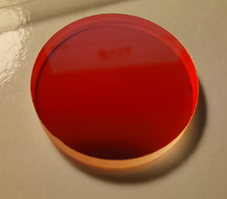
Example of a red flat dichroic filter
ND filters
ND stands for Neutral Density. Neutral density filters tends to reduce global the intensity of a signal without impacting the relative intensity of each wavelength. A Neutral Density filter is defined by it’s OD (Optical Density) value.
A ND0.3 will attenuate a signal intensity of 10^0.3 so reduce it by half, while a ND1 will attenuate by a factor 10 the signal.
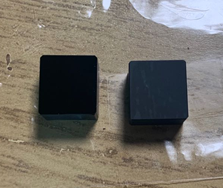
Example of ND filter, with OD0.2
Beamsplitters
Beamsplitters are used to separate by a specified ratio a signal in 2 distinct signals usually according to their polarisation. They can be made in cubes by gluing two birefringent triangular glass prisms on their hypotenuse, but can also come in different shapes, like plates or wedges with specific coatings.
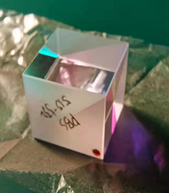
Optical beamsplitter cube
Where to buy optical filters ?
There is mainly two different ways to produce filters, by absorption with mostly color glass filters where the filtering comes directly from the raw material or interference filters made our of multilayer thin film deposition on a substrate.
Color glass filters raw material comes from optical glass manufacturers and can be further process by precision optics suppliers : cutting to shape, polishing, chamfering.
Interference filters will be realized on coating factories on precision optics substrates. Coating companies and precision optics suppliers can both be contacted for these parts, but as the key point is the coating quality it is better to deal with coating factories directly.
Alternatively, SINOPTIX offers optical filter solutions, don’t hesitate to send us your specific request.






